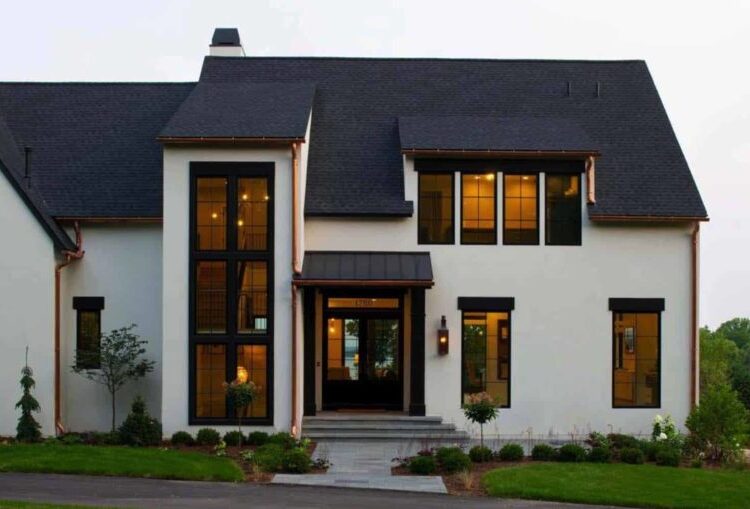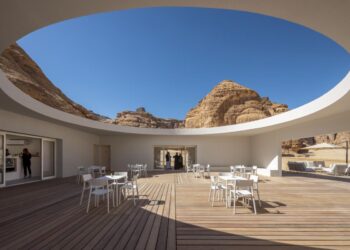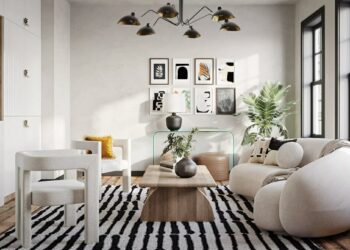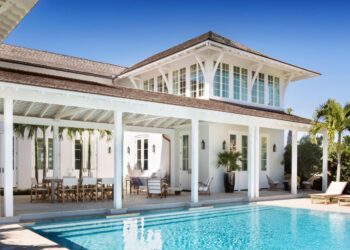The current appetite in interior design marks a significant return to heritage, yet with a decisive rejection of anything perceived as stuffy or outdated. This cultural confluence has given rise to the Modern Colonial Look—a highly sophisticated and commercially lucrative aesthetic that seamlessly marries the timeless architectural elegance of Colonial design (spanning American, British, Dutch, and French influences) with the clean lines, functionality, and open flow of contemporary living. This trend is not about replicating a museum; it is about distilling the best elements of the past—symmetry, quality craftsmanship, and rich materiality—and reintroducing them through a modern, comfortable, and personalized lens.
The foundation of the New Colonial Modern Look rests on two pillars: preserving the classic architectural bones of the style (high ceilings, wainscoting, pronounced millwork) and overlaying them with modern, transitional elements (minimalist furniture profiles, artistic lighting, and contemporary color palettes). This fusion creates spaces that offer both the grounding stability of history and the light, effortless ease of modern life.
For content creators focused on achieving high organic search traffic and premium monetization via Google AdSense, this trend is exceptionally potent. Keywords related to architectural updates, custom millwork, transitional furniture, and heritage renovation (Colonial Revival, Transitional Design, Bespoke Wainscoting, Modern Architectural Details) attract homeowners and renovators with substantial budgets. This article will provide an exhaustive blueprint for understanding and executing the Modern Colonial Aesthetic, detailing its key architectural components, material pairings, and strategic decorative choices that secure its place as a dominant trend for 2025 and beyond.
I. Architectural Foundations
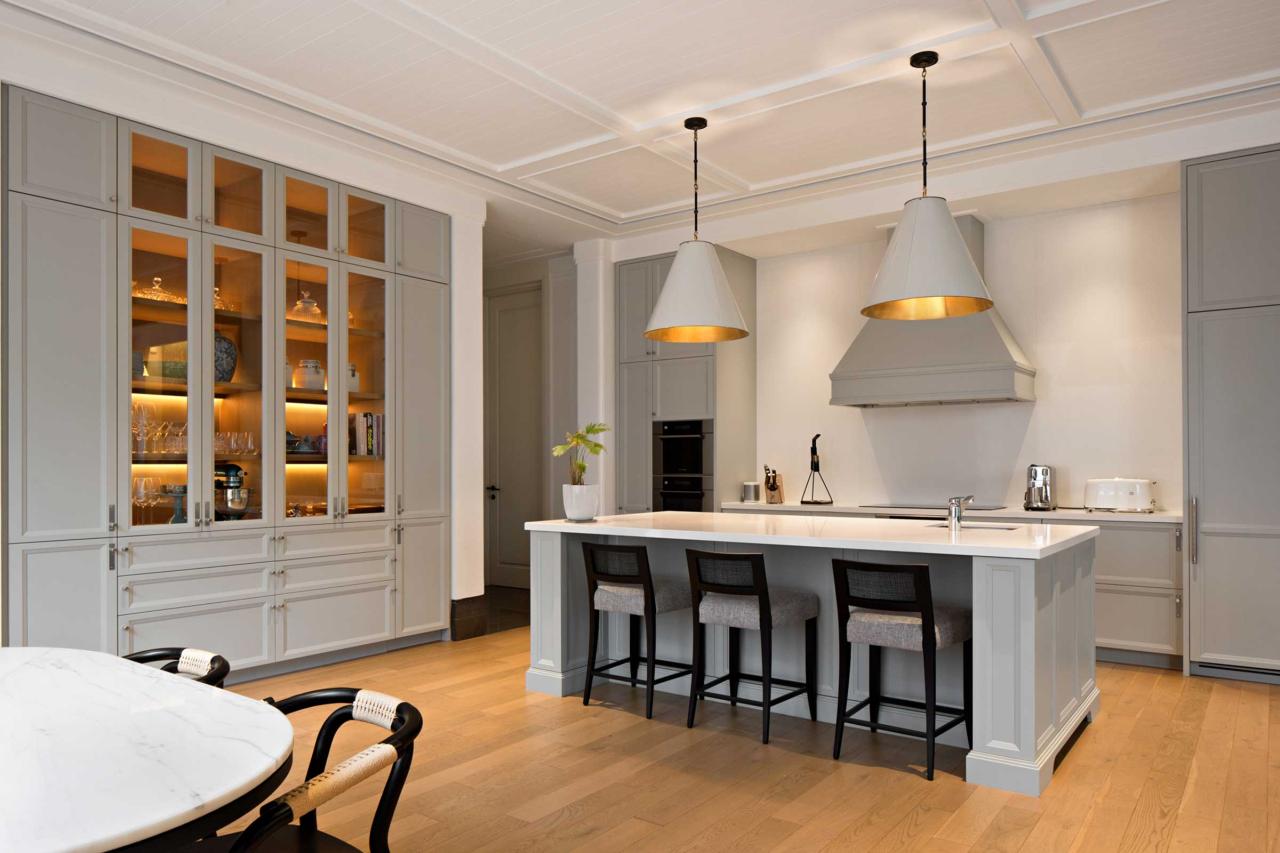
The success of the Modern Colonial style hinges on respecting and enhancing the historical architectural features, rather than stripping them away.
A. The Importance of Symmetry and Scale
Colonial architecture is defined by its proportional balance, which must be maintained in the modern interpretation.
A. Symmetrical Layouts: The traditional center-hall colonial, with rooms balanced equally on either side of a central axis, provides an innate sense of order and calm. The modern update often retains this central axis while Opening Up the back half of the house (kitchen and living areas) for better flow.
B. High Ceilings and Large Windows: Colonial homes typically feature generous ceiling heights and tall, multi-pane windows. These elements are crucial for maximizing Natural Light, a key component of modern design and Home Wellness Spaces. Window dressings should be simple (e.g., streamlined linen drapes) to avoid obscuring the light.
C. Balanced Furniture Placement: Even with a modern, eclectic mix of furniture, the placement should remain symmetrical—paired sofas, matching lamps, or identical console tables flanking a fireplace—to honor the colonial sense of order.
B. Millwork and Paneling
Pronounced trim and detailed wall treatments are the undisputed hallmarks of colonial style; in the modern context, these details are simplified but not eliminated.
A. Wainscoting and Trim: Adding crown molding, chair rail, and baseboards instantly elevates the room to a Luxury Decor status. In the modern version, the profiles of these moldings are often simpler and cleaner than their ornate historical counterparts, maintaining elegance without the fussiness.
B. Bespoke Wall Paneling: Using Wainscoting or applied molding (such as box paneling) on walls adds architectural depth. When painted in a sophisticated neutral color, the shadows and lines created by the trim become the dominant texture, echoing the high-end appeal of the Material Drenching Concept.
C. Updated Staircases: The heavy, carved wooden spindles of old colonial staircases are replaced with sleek, straight balusters, wrought iron, or dark, minimal metal railings. This maintains the structural presence while introducing a sharp, modern line.
II. The Modern Overlay
The “modern” component of this aesthetic is introduced through furniture profiles, lighting, and a strategic, curated mix of materials.
A. Furnishings: Transitional Profiles
The furniture palette is a careful blend of historical gravity and modern comfort, prioritizing quality materials and clean lines.
A. Pared-Back Upholstery: Traditional colonial furniture was often bulky. Modern Colonial pieces feature Clean Lines and streamlined silhouettes. Sofas and chairs are deeply comfortable (often upholstered in natural linen or rich leather) but avoid overly rolled arms or embellished skirts.
B. The Wood Foundation: Dark, high-quality woods such as mahogany, walnut, or rich oak remain fundamental, providing stability and historical depth. These pieces—often antique dressers or tailored library shelving—are juxtaposed with lighter, more contemporary seating.
C. Curated Mix-and-Match: The space should feel collected over time. This is achieved by mixing traditional elements (e.g., an heirloom antique chest) with bold, contemporary pieces (e.g., a Sculptural Lighting Art Piece chandelier or a minimalist, modern coffee table).
D. Material Juxtaposition: The use of Rich Textures is essential. Think traditional leather armchairs against a Corduroy Velvet Rich Textures sofa, or crisp white linen drapes against dark, traditional wood floors, creating a tactile and visual dialogue.
B. Lighting as Architectural Jewelry
Lighting is the primary tool for injecting a clear, contemporary edge into the classic colonial shell.
A. Statement Modern Fixtures: Replacing a traditional crystal chandelier with a bold, geometric, or Sculptural metal fixture (often brass or matte black) instantly modernizes the space. This strategic contrast highlights the intentional fusion of styles.
B. Layered Illumination: The lighting scheme should be highly functional, utilizing recessed downlighting for general ambiance, but focusing on task and accent lighting with visually interesting modern sconces and floor lamps.
C. Warm LED Technology: Using LEDs with a warm color temperature (around 2700K) ensures the light feels inviting and highlights the warm tones in the wood and paint, preventing the modern fixtures from feeling cold or harsh.
III. The Color and Material Palette
The Modern Colonial palette moves away from strict white or overly saturated period colors toward a more grounded, nuanced selection that supports both historical context and modern functionality.
A. The Grounding Palette
The color scheme is designed to feel permanent, sophisticated, and deeply connected to the natural world.
A. Earthy Neutrals: The foundational colors are warm and muted: creamy whites, soft taupes, bone, and light gray-greens. These serve as a calm backdrop, allowing the rich millwork and furniture to take center stage.
B. Deep Accents: For depth and a nod to traditional colonial colors, deep, rich hues are used sparingly. Think Deep Navy Blue, moody forest green, burgundy, or charcoal gray on kitchen islands, built-in shelving, or accent walls.
C. Warm Wood Tones: Dark Natural Hardwoods (like stained oak or mahogany) for floors and furniture contrast sharply with the lighter wall colors, emphasizing the structural integrity and historical grounding of the space.
B. Natural and Textured Materials
The texture in Modern Colonial is subtle but critical, providing depth without visual chaos.
A. Natural Stone: Natural Stone Finishes, such as marble, honed granite, or soapstone, are used extensively for countertops, fireplace surrounds, and bathroom vanities. These materials are chosen for their timeless pattern and cool touch, contrasting the warmth of the wood.
B. Natural Fabrics: Textiles are primarily composed of natural fibers—linen, cotton, wool, and rich leather. These fabrics are durable, breathable, and provide a tactile, lived-in feel, essential for a comfortable modern home.
C. Pattern Use: Patterns are introduced judiciously, often through botanical prints (a colonial staple), classic stripes, or simple plaids on pillows and window treatments, or via the use of Geometric Patterns in tilework (e.g., bathroom floors) for a modern punch.
IV. Strategic Application for High-Value Spaces
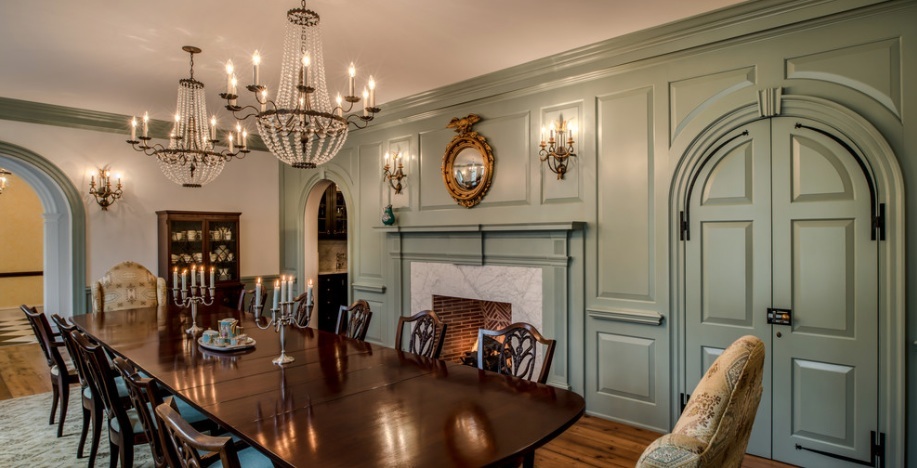
Implementing the Modern Colonial aesthetic is most impactful and commercially valuable in specific areas of the home that serve as primary selling points.
A. The Kitchen and Bath Update
A. Kitchen Cabinetry: Traditional Shaker Cabinets are preserved but painted in a contemporary color (e.g., a dusty blue or deep green). Hardware is often updated to sleek, modern pulls or simplified brass knobs, instantly bridging the old and new.
B. Large Island and Flow: The colonial kitchen is opened up to the living area. A large, central island becomes the functional hub, often topped with a single slab of Marble or Soapstone and featuring bespoke Fluted Paneling for modern texture.
C. Spa-like Bathrooms: Bathrooms feature traditional elements (pedestal sinks, clawfoot tubs) but use modern materials (large-format tile, glass walk-in showers, and marble slabs), creating a luxurious, functional Home Wellness Space.
B. The Home Office and Library
A. Built-in Shelving: Traditional colonial paneling is used to create bespoke, floor-to-ceiling built-in shelving, often painted in a moody, deep color. This anchors the room and provides a sophisticated setting for the modern Home Office.
B. Leather and Wood: Furnishings include a classic wooden desk and a rich, leather accent chair. These materials provide the necessary gravitas and warmth associated with historical intellectual spaces.
C. The Commercial Edge and ROI
A. Transitional Appeal: This style appeals to the broadest segment of the luxury buying market, satisfying those who desire the character of an old home and the functionality of a new one. This wider appeal increases market value.
B. Investment in Architecture: Expenditures on permanent architectural features—millwork, high-quality windows, and natural stone—provide a higher, more reliable Return on Investment (ROI) than spending on temporary decor.
Conclusion
The New Colonial Modern Look is an architectural philosophy built on the foundation of enduring quality, symmetry, and warmth. It stands as a sophisticated rejection of disposable design, proving that the most valuable homes are those that celebrate their heritage while relentlessly embracing modern comfort and functionality. By carefully editing the colonial aesthetic—stripping away the fussy ornamentation while retaining the rich architectural elements like high ceilings and detailed Wainscoting—designers have forged a style that is both deeply familiar and refreshingly contemporary.
This trend’s power lies in its Transitional Design approach. It allows homeowners to anchor their spaces with the stability of dark, rich Natural Hardwoods and symmetrical layouts, then personalize and modernize with Sculptural Lighting, Clean-Lined Furniture, and a calming palette of Earthy Neutrals accented by deep, complex hues. The result is a home that tells a story of history and quality craftsmanship but functions effortlessly for today’s busy lifestyle, easily integrating Discreet Smart Tech and creating sought-after Home Wellness Spaces.
Commercially, the Modern Colonial Aesthetic is a prime subject for high-value content. The materials and processes involved—custom millwork, natural stone sourcing, luxury lighting, and bespoke furniture—are all associated with significant consumer investment. Content optimized for keywords like Bespoke Wainscoting, Modern Colonial Kitchen Revival, and Transitional Furniture for Colonial Homes attracts an affluent, high-intent audience. This targeted strategy is essential for maximizing Google AdSense revenue, as the corresponding ad inventory for custom building and high-end design services is consistently high-paying.
In its truest form, the Modern Colonial Look is the ultimate expression of “collected” style: a home that appears to have evolved gracefully over generations, meticulously maintained, and updated only with the highest quality, most enduring materials. This blend of elegance, permanence, and contemporary livability secures the Modern Colonial aesthetic not just as a passing trend for 2025, but as a timeless model for sophisticated residential design.

